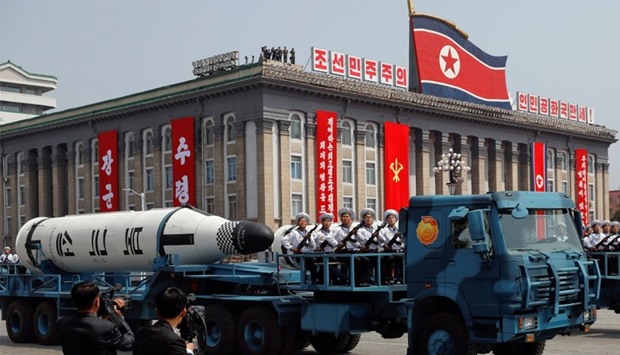North Korea Sunday staged a fresh missile test, a day after staging a defiant giant military parade and hours before US Vice President Mike Pence arrived in South Korea for talks on curbing Pyongyang's weapons programmes.
The South Korean and US military said the latest launch -- conducted as tensions rose over the North's nuclear ambitions -- was a failure.
‘The missile blew up almost immediately,’ the US Defense Department said of the early-morning launch from near Sinpo on the North's east coast.
The type of missile was not clear.
The test came after North Korea displayed nearly 60 missiles -- including what is suspected to be a new intercontinental ballistic missile -- at a parade on Saturday to mark the 105th birthday of its founder Kim Il-Sung.
It was also staged hours before Pence arrived in South Korea on a tour which will also include Japan, Indonesia and Australia.
North Korea has a habit of firing off missiles to mark major political anniversaries, or as gestures of defiance to top US officials visiting the region.
US Defense Secretary Jim Mattis said President Donald Trump had been briefed on the latest test but had ‘no further comment’.
‘It is likely that this launch is a test for a new type of missile or an upgrade so the possibility is high for further provocation in the near future,’ said Kim Dong-Yub, of Kyungnam University's Institute of Far Eastern Studies in Seoul.
South Korea's foreign ministry said that by conducting the latest test just a day after showcasing a series of missiles, ‘North Korea has threatened the whole world’.
- Tough stance -
Last August a submarine-launched ballistic missile tested from Sinpo flew 500 kilometres (300 miles) towards Japan.
North Korean leader Kim Jong-Un hailed that test as the ‘greatest success’ and said it brought the US mainland within range of a mobile delivery system.
Pyongyang's rogue atomic ambitions have come into sharp focus in recent weeks, with Trump vowing a tough stance against the North and threatening unilateral action if China failed to help curb its neighbour's nuclear programme.
Trump has repeatedly said he will prevent Pyongyang from developing a nuclear-tipped ballistic missile capable of reaching the mainland United States.
With speculation mounting that the North is preparing to conduct a sixth nuclear test, he sent an aircraft carrier-led strike group to the Korean peninsula.
But a White House foreign policy adviser travelling with Pence played down Sunday's test, saying the missile -- probably a medium-range one -- failed after about four to five seconds.
While Washington had a ‘wide array of tools’ at the president's disposal, ‘for this particular case, if they (North Korea) took the time and energy to launch a missile that failed, we don't need to expend any resources against that.’
Asked if a nuclear test was still expected, the adviser said Kim Jong-Un had stated he wanted to do both a nuclear test and a missile launch.
‘We've seen one -- it doesn't prevent him from doing the other.’
The North has reiterated its constant refrain that it is ready for war with the US, and its army vowed Friday a ‘merciless’ response to any US provocation.
Recent satellite images suggest its main nuclear site is ‘primed and ready,’ according to specialist US website 38North, and White House officials say military options are already being assessed.
China, the North's sole major ally, and Russia have both urged restraint, with Beijing's Foreign Minister Wang Yi warning that ‘conflict could break out at any moment’.
The UN Security Council has imposed six sets of sanctions against the North since its first nuclear test in 2006 -- all of which have failed to halt its drive for what it insists are defensive weapons.
Pyongyang has carried out five nuclear tests -- two of them last year -- and multiple missile launches.
It has yet to formally announce it has an operational ICBM, but experts and intelligence officials have warned it could be less than two years away from achieving an inter-continental strike capability.
Operational submarine-launched devices could give the North the ability to strike without warning from a vessel somewhere in the Pacific Ocean.
They could also reduce the effectiveness of the US Terminal High Altitude Area Defense system (THAAD), which Washington and Seoul are deploying in the South to counter missile threats, to the fury of Beijing.
On Monday Pence is scheduled to meet Acting President Hwang Kyo-Ahn for talks on the North's weapons programmes and on THAAD.


